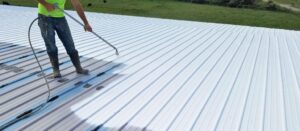Understanding the Environmental Impact of Roof Coatings
Posted by Xavier Lentoose in Business on Apr 13th, 2025 | Comments Off on Understanding the Environmental Impact of Roof Coatings As sustainability becomes a central focus in modern construction and home improvement, roof coatings have gained attention not only for their functional benefits but also for their environmental impact. Homeowners, commercial property managers, and builders are increasingly interested in how these products affect energy consumption, greenhouse gas emissions, and overall building efficiency. Understanding the environmental consequences of roof coatings is crucial for making informed choices that support both long-term performance and eco-friendliness. Browse this site for professional advice on when and why to apply roof coatings.What Are Roof Coatings and Why Are They Used?
Roof coatings are protective layers applied to existing roof systems to extend their lifespan, improve energy efficiency, and enhance weather resistance. They are commonly made from acrylic, silicone, polyurethane, or asphalt-based materials and can be applied to various roof types, including metal, concrete, and bitumen. These coatings are designed to reduce wear and tear caused by UV rays, rain, wind, and thermal expansion, which over time can cause cracking, leaks, and structural damage.
By reflecting sunlight and creating a barrier against moisture, roof coatings can help reduce interior temperatures during hot weather, decrease the load on HVAC systems, and delay costly roof replacements. While the practical advantages are clear, the question remains: how do these benefits align with environmental sustainability?
Energy Efficiency and Reduced Carbon Emissions
One of the most notable environmental benefits of roof coatings is their role in improving energy efficiency. Reflective coatings, often referred to as “cool roof coatings,” are designed to reflect a significant portion of solar radiation rather than absorbing it. This reduces the heat transferred into a building, ultimately lowering the need for air conditioning and minimizing energy consumption during warm months.
The reduction in energy use translates directly into fewer carbon emissions, especially in regions where electricity is primarily generated from fossil fuels. This makes roof coatings an important tool in mitigating urban heat islands—a phenomenon where densely built environments retain heat, causing local temperatures to rise. By cooling down individual structures, reflective roof coatings contribute to a more sustainable urban climate.
Material Composition and Environmental Trade-Offs
While the energy-saving advantages are significant, it’s important to consider the environmental impact of the materials used in roof coatings. Many coatings contain synthetic chemicals and petroleum-based compounds, which require energy-intensive manufacturing processes and can contribute to environmental degradation if not properly managed.
Acrylic coatings, for example, are water-based and generally considered to be more environmentally friendly compared to solvent-based alternatives. Silicone coatings offer excellent resistance to weathering and UV exposure, but their production may involve more complex chemical processes. Polyurethane coatings provide strong protection but often include volatile organic compounds (VOCs), which can contribute to air pollution and pose health risks during application if not handled correctly.
Manufacturers are increasingly developing low-VOC and VOC-free formulations, which lessen the impact on air quality and reduce health hazards for workers and building occupants. Choosing eco-labeled or certified sustainable coatings can be a way to ensure a more responsible product selection.
Waste Reduction and Lifecycle Extension
Another significant environmental benefit of roof coatings lies in their ability to extend the life of existing roofing systems. Rather than tearing off and disposing of an old roof—an approach that contributes to construction waste—applying a coating can restore functionality and delay the need for replacement by several years. This not only reduces landfill use but also lessens the demand for new roofing materials, which require raw material extraction, manufacturing, and transportation—all processes that consume energy and generate emissions.
Roof restoration through coatings can be especially advantageous for commercial buildings with large surface areas. When applied correctly and maintained over time, coatings can be reapplied to provide ongoing protection, creating a sustainable maintenance cycle that supports resource conservation.
Considerations for Climate and Application
It’s also worth noting that the effectiveness and environmental impact of roof coatings can vary depending on the local climate and specific building needs. In hotter climates, reflective coatings are highly beneficial in lowering indoor temperatures and conserving energy. In colder regions, however, the benefits may be less pronounced, and the reflective properties could reduce passive solar heating during winter.
Proper installation and maintenance are also essential for ensuring that coatings deliver their environmental benefits over the long term. Improper application can lead to premature failure, necessitating additional coatings or repairs, which diminish the ecological advantages.


